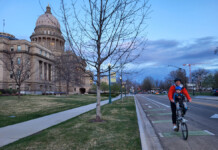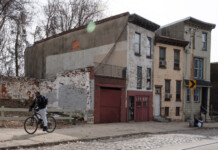Feds make it difficult to create bicycle-friendly streets
Editorial by Chad Mullins, Chair, Salt Lake County Bicycle Advisory Committee
Another serious bicycle accident “Bicyclist flown to hospital after colliding with vehicle” (Salt Lake Tribune, July 14) again demonstrates the need for safer streets.
Salt Lake County officials attempted to incorporate a more bicycle friendly street design in their recently completed road improvements on 3900 South – the same street where the accident occurred. However, because Federal stimulus highway funds were used, changes to the existing roadway configuration required Federal Highway Administration (FHWA) approval.
In spite of the Department of Transportation’s avowed bicycle friendly national transportation policy, government bureaucracy prevailed and the requested design changes were rejected.
Safer routes that accommodate all street users, pedestrians and bicyclists as well as motorists, are needed throughout the Wasatch Front. 3900/4100 South has been identified as a primary bicycle route. It represents one of the few east-west arterials that do not confront bicyclists and pedestrians with the challenge of negotiating an I-15 Freeway interchange while providing access to public transit.
Unfortunately, there is minimal bicycle/pedestrian friendly infrastructure to encourage and promote safe bicycling on 3900 South and other designated bicycle routes in the Wasatch Front. Some sections of the roadway have no room on the shoulders to safely accommodate bicyclists which forces bicyclists to share the travel lane with motorized traffic.
For safety reasons national guidelines recommend that bicycle routes with “shared lanes should not be used on roadways that have a speed limit above 35 mph.” The posted speed limit on most of 3900/4100 South is 40 mph. The speed limit on roadways identified as bicycle routes should be reduced to 35 mph or slower.
The recent road improvement project on 3900 South afforded the County an opportunity to improve conditions on a portion of the roadway. The County had previously developed plans to widen the pavement and improve the section of 3900 South between Honeycutt Road (1850 East) and 2300 East. County officials took advantage of Federal stimulus funds to assist in funding the project and obtained additional funding for the repaving 3900 South further west to Highland Drive.
Although the County street design included a wider shoulder to accommodate bicycling and on-street parking, bicycle lanes were not provided. Bicycle lanes would have provided a much safer street design according to “best practices,” which identify “bicycle lanes as the appropriate and preferred bicycle facility for thoroughfares.” The County incorporated signage designating this section as a bicycle route and posted “Share the Road” signs.
The steep grade immediately east of the intersection of 3900 S with Highland Drive presents a special hazard to bicyclists and motorists because bicyclists are moving uphill at a much slower speed than the motorized traffic. It is important for the safety of bicyclists to have room to maneuver outside of the vehicular travel lane in these situations.
Repaving the road surface provided an opportunity to restripe the lanes with narrower travel lane widths creating space for a shoulder. The County requested FHWA approval to reduce the existing travel lane widths, staying within the ranges recommended under national guidelines. Providing a shoulder for bicyclists would have made this portion of the roadway much safer for everyone.
The requested changes to this section of the roadway came late in the process, but the rejection negates the purported bicycle and pedestrian friendly transportation policies of the current administration. The recently released draft of the DOT Strategic Plan 2010 – 2015 advocates “the adoption of ‘complete streets’ policies and programs that improve pedestrian and bicyclist safety. . . Complete streets are designed and operated to enable safe, attractive, and comfortable access and travel for all users.”
Both Salt Lake City and Salt Lake County adopted “complete streets” ordinances in the past year.
Transportation Secretary LaHood made headlines in March saying, “This is the end of favoring motorized transportation at the expense of non-motorized. We are integrating the needs of bicyclists in federally funded road projects.”
His recommendation was to “improve non-motorized facilities during maintenance projects.”
However, in practice the use of Federal stimulus monies for road repairs and improvements hampered local efforts to provide more bicycle-friendly infrastructure.
[Note: This editorial also appeared in the Salt Lake Tribune]







